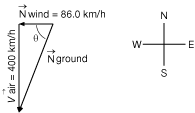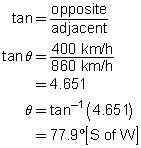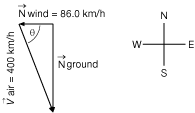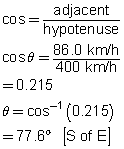Module 2—Motion in Two Dimensions
 Read
Read
Read “Relative Motion” on pages 91 to 100 of your textbook.
 Self-Check
Self-Check
SC 5. A jetliner flying at 725 km/h [W] encounters a headwind of 70 km/h [E]. What will be the velocity of the jet relative to the ground?
 Self-Check Answer
Self-Check Answer
SC 5. The velocity of the jet will be (725 km/h – 70 km/h) [W] = 655 km/h [W].
 Lesson 2 Lab: Table Tennis in the Wind
Lesson 2 Lab: Table Tennis in the Wind
Complete the procedure of “2-3 QuickLab: Table Tennis in the Wind” on page 92 of the textbook.
LAB 3. Answer questions 1, 2, 3, and 4 of “2-3 QuickLab: Table Tennis in the Wind” on page 92 of the textbook.
 Read
Read
What happens when the wind blows at an angle to the airplane? This is where the use of components, which you have been practising, becomes a key skill in solving problems. Read “Non-collinear Relative Motion” on pages 93 to 97 of your textbook to see how they are used.
 Self-Check
Self-Check
SC 6. An airplane with airspeed of 400 km/h is flying south, but an east wind of 86.0 km/h blows the plane off course.
-
What was the actual velocity of the plane?
-
In what direction should the pilot fly to head due south?
 Self-Check Answers
Self-Check Answers
SC. 6
Given

Required
- actual velocity of plane (
 ground)
ground) - heading to fly directly south (θ)
Analysis and Solution
Designate south and west as positive directions.

a. 

b. The resultant is the ground velocity of the airplane.


Paraphrase
- The actual velocity of the plane is 409 km/h [77.9° S of W].
- The heading of the plane needed to fly directly south is 77.6° S of E.
 Module 2: Lesson 2 Assignment
Module 2: Lesson 2 Assignment
Remember to submit the answer to TR 3 to your teacher as part of your Module 2: Lesson 2 Assignment.
 Try This
Try This
TR 3. An aircraft has a cruising speed of 100 m/s. On this particular day, a wind is blowing from the west at 75.0 m/s.
- If the plane were to fly due north, what would be the velocity relative to the ground?
- If the pilot wishes to have a resultant direction of due north, in what direction should the plane be pointed? What will be the plane’s displacement in 1.25 h?
 Read
Read
What happens when the motion is on water and the currents are not perpendicular to the direction of travel? Again, components become the key in solving these problems. Read “Relative Motion in the Water” on pages 98 to 100 of your textbook to see how they are used.
 Module 2: Lesson 2 Assignment
Module 2: Lesson 2 Assignment
Remember to submit the answers to TR 4, TR 5, and TR 6 to your teacher as part of your Module 2: Lesson 2 Assignment.
 Try This
Try This
TR 4. A dog wishes to swim across a slow-moving stream. The dog can swim at 2.0 m/s in calm water. The current velocity is 3.0 m/s. The distance directly across the stream is 50 m.
- If the dog points himself directly across the stream, how long will it take to get across the stream?
- How far downstream will the current have carried the dog when the dog gets to the other side?
- What was the dog's velocity relative to the bank from where the dog started?
TR 5. For each of the following vectors, calculate the horizontal and vertical components.
- 25.0 m/s [35.0°] (polar positive)
- 16.0 m [120°] (polar positive)
- 125 km/h at 220° (polar positive)
TR 6. A man walked 440 m [50.0°] (polar positive) and then 580 m [185°] (polar positive). The entire trip took 150.0 min.
- What was the total distance travelled?
- What was the displacement of the man?
- What was the average speed of the man (in m/min)?
- What was the average velocity of the man (in m/min)?